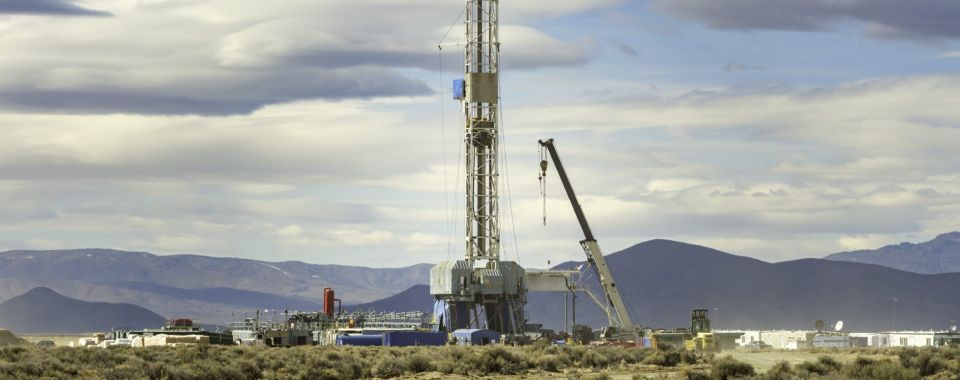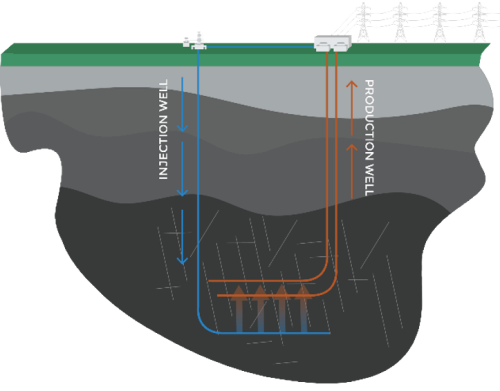
A drilling rig at Fervo Energy's Project Red enhanced geothermal pilot project in Nevada (photograph courtesy of Fervo Energy).
By Colton Poore, Andlinger Center for Energy and the Environment
February 16, 2024
Many consider geothermal to be an around-the-clock clean energy resource, but according to a Princeton-led study in collaboration with startup Fervo Energy, operating new geothermal plants flexibly could provide the best value for the grid.
By leveraging the inherent energy storage properties of an emerging technology known as enhanced geothermal, the research team found that flexible geothermal power combined with cost declines in drilling technology could lead to over 100 gigawatts’ worth of geothermal projects in the western U.S. — a capacity greater than that of the existing U.S. nuclear fleet. Such an innovation would transform geothermal energy from its niche status on the grid today into a major component of a decarbonized future. The researchers published their analysis January 15 in Nature Energy.
“People generally think of geothermal as this always-on, baseload energy source, but we’ve shown that there’s a lot of extra value to be had in operating these plants in a different way,” said research leader Jesse Jenkins, assistant professor of mechanical and aerospace engineering and the Andlinger Center for Energy and the Environment.
Since the early 20th century, people have been harnessing the earth’s heat to produce electricity, but these conventional geothermal power plants require a specific set of conditions: hot, permeable rocks close to the earth’s surface, and some sort of fluid to transport heat up from underground. These requirements have limited traditional geothermal energy to only a handful of favorable locations in the western United States and Hawaii — places with naturally occurring geysers, volcanoes, and hot springs. Consequently, geothermal plants generated only 0.4% of the total electricity in the U.S. in 2022.
Yet advances in drilling and hydraulic fracturing technologies have unlocked the enhanced geothermal approach, which removes the need for permeable rocks and greatly expands access to the heat that already exists far beneath our feet.

In the approach, engineers dig two or more boreholes into impermeable rock that extend thousands of feet below the earth’s surface, then drill similar distances horizontally, and subsequently create fracture networks in the horizontal sections to connect those holes deep underground. Afterward, they inject a fluid into one borehole, which heats up as it travels through the fractures. That heated fluid can be pulled up through the other wells and subsequently used to generate electricity.
“Enhanced geothermal is much less geographically dependent than conventional geothermal, which is really only possible in a small number of ideal spots,” said Wilson Ricks, first author of the study and a graduate student in mechanical and aerospace engineering. “With enhanced geothermal, you can open up wide swathes of the country — wherever you can dig down and find hot rocks close to the earth’s surface.”
Adding value through flexibility
Efforts to develop and scale enhanced geothermal energy have historically focused on lowering the costs associated with drilling and other equipment. The U.S. Department of Energy unveiled an Enhanced Geothermal Shot in 2022, for example, which calls for a 90% cost reduction of enhanced geothermal technologies by 2035.
But in their research, the team found an alternate avenue to make geothermal power more market-competitive: flexibility.
By operating enhanced geothermal power plants flexibly — using the inherent energy storage capabilities offered by enhanced geothermal reservoirs to generate more or less energy as needed — the team found that the value of geothermal energy dramatically increased because it could complement and compensate for intermittent energy sources such as solar and wind.
“Wind and solar are now the cheapest sources of clean energy, but their downfall is their variability and weather dependency,” said Jenkins. “You can earn a lot of additional revenue if you can find a way to shift your clean energy generation to times without wind and solar.”
Fortunately for enhanced geothermal, it can do just that.
As Ricks explained, the impermeable rock required for enhanced geothermal also functions as a self-contained underground reservoir for heated fluid that acts like a giant energy storage system.
Analogous to how a conventional battery can be charged and discharged to store and release energy, operators can change how fast they inject and extract fluid into the enhanced geothermal system to shift between energy production and energy storage. To “charge” the system, engineers would simply inject more fluid underground than they pull out, filling up the reservoir with heated fluid and building up pressure. And when clean energy is most needed, this heated, pressurized fluid can be discharged to the earth’s surface to generate electricity.
“Because enhanced geothermal comes with its own variation of energy storage, you’re able to shift how you operate the plant to generate as much power as possible at the times when it’s most valuable to the grid,” said Ricks. “That added flexibility allows enhanced geothermal to avoid generating energy when wind and solar are active and electricity prices are extremely low, something many alternative energy sources struggle to do.”
Flexibility in practice
Adding flexible operations to enhanced geothermal made the technology more valuable and increased its optimal installed capacity in every scenario, even without further cost declines in drilling technologies. In fact, scenarios that assumed flexible operations were similarly impactful to the deployment of geothermal as scenarios that only assumed lower drilling costs. Combining flexible operations and cost declines, the team found that geothermal energy could add up to over a third of the installed clean energy capacity in the western U.S.
Moreover, adding flexibility to an otherwise baseload geothermal plant would only require a few changes at the aboveground facility. Engineers would have to overbuild the capacity of the power station to accommodate for the times when the plant is discharging as much heated fluid to the surface as possible, and they would need infrastructure to store additional fluid for the “charging” periods, when more fluid is being injected than produced.
But below ground, the baseload and flexible systems would look nearly identical.
“That’s one of the real advantages here: the core technology — in terms of the wells and the subsurface engineering — doesn’t change. Once you’ve built the wells, the subsurface system is inherently flexible,” said co-author Jack Norbeck, chief technology officer and co-founder of Fervo Energy, a startup focused on developing enhanced geothermal resources.
In field testing at its commercial Project Red plant in Nevada, Fervo Energy has demonstrated energy storage capabilities exceeding five days. When translating that field data into physical models, Norbeck said there were scenarios in which the system could achieve over 10 days of energy storage.
“When you consider that many people are currently quantifying long-duration energy storage as anything over eight to ten hours, that’s very exciting to be already demonstrating something above five days,” Norbeck said.
While initial field tests have validated many projections, Norbeck said work is still needed to demonstrate the robustness of flexible operations over many charge/discharge cycles and to characterize certain system properties like roundtrip efficiency. He added that flexible geothermal power will also require innovations to contract structures, since purchasing agreements for geothermal energy often assume that plants will operate as a baseload energy source.
With support from the Advanced Research Projects Agency for Energy (ARPA-E), Fervo Energy and Princeton’s ZERO Lab will continue their collaboration to explore these advanced geothermal techniques in the field and in computer models, answering key questions about the potential role of geothermal energy, as well as the necessary steps for achieving that role.
“In earlier work, we’ve looked at the value of adding flexible operations to a single, first-of-its-kind enhanced geothermal plant, and in this work, we’ve answered the broader question of how flexible geothermal might fit into a future decarbonized energy system,” Ricks said. “The next step is to look at the intermediate timescale to understand how enhanced geothermal can get from the nascent technology it is today to become the clean energy heavy hitter we’ve shown it can be.”
The paper, “The role of flexible geothermal power in decarbonized electricity systems,” was published January 15 in Nature Energy. In addition to Jenkins, Ricks, and Norbeck, co-authors include Katharine Voller and Gerame Galban of Fervo Energy. The work was supported by the U.S. Department of Energy Office of Science Small Business Innovation Research program, ARPA-E, and Princeton University’s Zero-carbon Technology Consortium.